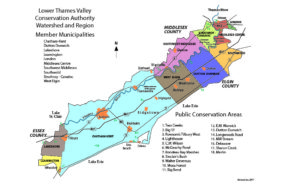Select a question to expand the answer
By definition, conservation is “the wise management and use of natural resources”, primarily renewable natural resources including water, soil, vegetation and wildlife.
A watershed refers to an area drained by a particular watercourse and its tributaries.
A Conservation Authority (CA) is an autonomous corporate body established under the CA Act of Ontario. CA’s manage renewable natural resources on a watershed basis. Projects are initiated locally by the CA’s member municipalities to meet regional (jurisdictional) conservation needs.
CA’s work in partnership with their local member municipalities, the Provincial and Federal Government Ministries and Departments, special interest groups, businesses, corporations and individuals.
The objectives of a CA are to establish and undertake, in the area over which it has jurisdiction, a program designed to further the conservation, restoration, development and management of natural resources.
There are 36 Conservation Authorities established throughout Ontario.
Conservation Authorities study and investigate the watershed and determine a program whereby the natural resources of the watershed may be conserved, restored, developed and managed.
A watershed refers to an area drained by a particular watercourse and its tributaries.
The Lower Thames Valley Conservation Authority has jurisdiction over the watersheds of all streams which drain into the Thames River from the village of Delaware to Lake St. Clair. Its southern boundary has jurisdiction over the watersheds of all streams which drain into Lake Erie, from the Talbot Creek watershed in the east to the Two Creeks watershed in the west. This area of jurisdiction covers over 3,275 square kilometres (1,264 square miles) and includes 10 member municipalities.


